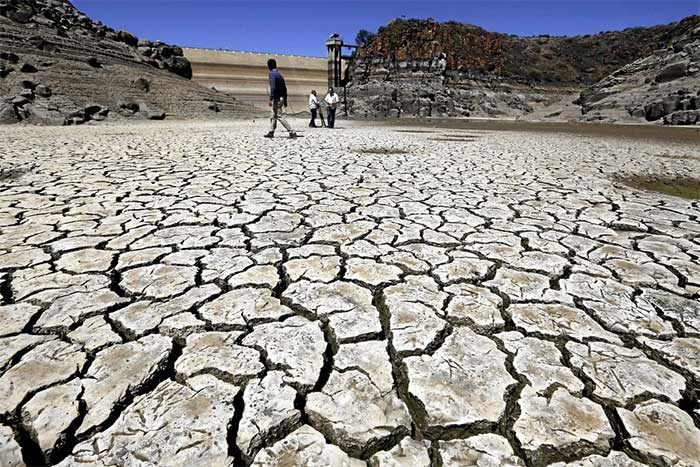Events that were once unimaginable are becoming common as global temperatures continue to rise, exceeding even the forecasts of experts.
The heat envelops the capital of Mali like a heavy, suffocating blanket. For nearly a week in early April, temperatures in Bamako hovered above 43 degrees Celsius. Ice prices skyrocketed to ten times their normal rate, and the power grid was disrupted and ceased to function.
With a majority of the country’s Muslim population fasting during the month of Ramadan, instances of dehydration and heatstroke have become a “plague.”
As body temperatures rise, people’s blood pressure drops. Their vision blurs, their kidneys and livers struggle, and their brains begin to swell. At the city’s main hospital, doctors reported a death toll in just four days that was nearly equivalent to that of an entire month. Local cemeteries are overwhelmed, according to the Washington Post.
This historic heatwave engulfing Mali and several other areas in West Africa this month is something scientists say “would be nearly impossible” if the world were not facing human-caused climate change.
It is considered the latest manifestation of a sudden and alarming rise in global temperatures.
Abnormalities
Fueled by decades of unchecked fossil fuel burning and the emergence of the El Niño climate pattern in June 2023, the planet has exceeded the concerning threshold of 1.5 degrees Celsius above pre-industrial levels this year.

Every month over the past 10 months has been the hottest on record. (Photo: Bloomberg).
Nearly 19,000 weather stations recorded record high temperatures since January 1. Each month over the past 10 months has been the hottest on record.
Researchers state that the scale and intensity of this heatwave are abnormal even when considering the unprecedented levels of greenhouse gases in the atmosphere.
Gavin Schmidt, director of NASA’s Goddard Institute for Space Studies, mentioned that what happens in the coming months could tell us whether Earth’s climate is undergoing a fundamental change.
This could represent a quantum leap in warming, disrupting climate models and leading to more dangerous extreme weather phenomena than ever before.
The Mysterious Heatwave
As the world entered the El Niño climate pattern, scientists knew it would begin breaking temperature records.
However, not only did it break records, but it also obliterated them.
Four consecutive days in July 2023 became the hottest days on record. The Northern Hemisphere experienced the warmest summer and then the warmest winter known to science.
By the end of 2023, the average global temperature was nearly 1.5 degrees Celsius above pre-industrial averages. Temperatures were also about 0.2 degrees Celsius warmer than climate modelers had predicted, even accounting for the impact of El Niño.

Nearly 19,000 weather stations recorded record high temperatures since January 1. (Photo: Bloomberg).
Researchers have spent months seeking explanations for this 0.2 degrees Celsius discrepancy. It could be due to a volcanic eruption that released heat-retaining water vapor into the atmosphere, or changes in transportation fuels affecting cloud formation that obscures sunlight.
However, so far, these factors can only partially explain the anomaly. This raises concerns that scientists’ models may not fully capture the long-term changes in the climate system.
“What if the statistical connections we rely on for predictions are no longer valid?”, Schmidt said. “I keep wondering if the past is no longer a guide to the future.”
Another test will occur in the coming months as the planet transitions from El Niño to its opposite pattern, La Niña. The U.S. National Weather Service predicts this will happen in the summer.
Since La Niña is often associated with cooler global temperatures, scientists hope it will end the streak of record heat on Earth.
A Completely New Weather Pattern
Even if the average global temperature returns to a more predictable trajectory, the impacts of warming on humans and ecosystems have reached uncharted territories.
The sea ice extent around Antarctica reached record lows in 2023.
The water levels of the Amazon River also dropped to the lowest since measurements began.
This week, researchers announced a global coral bleaching event and warned that the crisis in the oceans is on track to set records.

Events that were once unimaginable are becoming common as the world heats up. (Photo: Esa Alexander/Sunday Times).
In a city in Mali, researchers reported that mercury thermometers reached 48.5 degrees Celsius – possibly the hottest temperature ever recorded in Africa.
Nighttime does not offer any respite, with temperatures frequently exceeding 32 degrees Celsius. High nighttime temperatures are particularly dangerous because they do not allow the body to recover.
Kiswendsida Guigma, a climate scientist and advisor at the Red Cross Climate Center based in Burkina Faso, said he hardly slept during the heatwave. Frequent power outages left him unable to even use a fan.
He added that very few people in the area can use air conditioning. The architecture of poor residential areas, where buildings are often constructed with heat-retaining bricks and metal roofs, exacerbates the danger.
“We are used to the temperatures, but we have never experienced this level of severity,” Guigma said. “We will soon reach the brink, the limit that humans can endure.”
The analysis of the heatwave is the latest report from World Weather Attribution. It shows that events once unimaginable are becoming common as the world heats up.
The team also stated that the extreme heatwave in October 2023 in Madagascar – where record temperatures lasted for 10 days – “would not have occurred” without human-induced warming.
Heavy rainfall in Libya contributed to a catastrophic dam collapse that killed thousands, and the likelihood of such an event is now 50 times higher due to climate change.
Clair Barnes, a researcher at the Grantham Institute at Imperial College London, noted that the heatwave in West Africa is unprecedented. However, if the world warms by 2 degrees Celsius, heatwaves of such intensity will occur every 10 years.
“If we continue to emit carbon dioxide and other greenhouse gases into the atmosphere, the world will continue to warm… and this will only get worse,” Clair Barnes commented. “The sad truth is that this is not the new normal. This is the path toward the unpredictable.”




















































